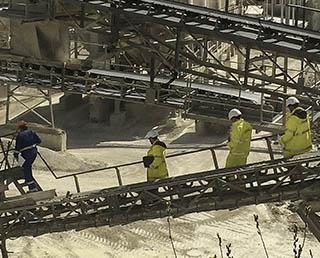Prevent These Four Common Problems with an Annual Belt Conveyor Assessment
April 24, 2018
 As we move further into 2018, it is important to take a moment and reflect on the plans and objectives that were set for the year ahead. In a short time, we can find ourselves behind on the goals we vowed to keep over the year if we’re not mindful of our progress. Conducting an independent assessment of your belt conveyor system is one such action item that should be taken soon to stay on course for a successful 2018.
As we move further into 2018, it is important to take a moment and reflect on the plans and objectives that were set for the year ahead. In a short time, we can find ourselves behind on the goals we vowed to keep over the year if we’re not mindful of our progress. Conducting an independent assessment of your belt conveyor system is one such action item that should be taken soon to stay on course for a successful 2018.
Flexco recommends all belt conveyor systems receive a thorough review at least once per year, and the spring season is an ideal time to have this done. These assessments are most effective when conducted by an outside party not familiar with the day-to-day operations that can provide a fresh set of eyes. The assessment should be comprehensive, reviewing every component of the system, to help identify potential problems and proactively address any maintenance issues.
After conducting thousands of belt conveyor assessments on operations of all sizes, here are the four most commonly identified belt conveyor challenges Flexco has found in an assessment:
Carryback
Conveyor belt carryback is one of the most common and most costly issues impacting an operation. While material sticking to the conveyor belt may seem like an inevitable “cost of doing business,” it presents real concerns and challenges. In fact, CEMA conservatively estimates carryback to be as high as three tons per week, given a 60" wide belt traveling at 800 feet per minute. Over the course of a full year, this is over 150 tons of material for one belt. If carryback on a conveyor can be reduced from 3% to 1%, it can result in a 67% reduction in conveyor maintenance costs.
Carryback can lead to conveyor belt damage and/or downtime, lost productivity, and possibly even safety hazards. It can be easy for someone who works with the conveyor belt every day to overlook or disregard clear signs of carryback, further underscoring the need for a fresh set of eyes available from an outside assessment.
Mistracking
Where there is carryback, there is likely to be conveyor belt mistracking. Buildup on the rollers can cause the belt to drift to one side, but mistracking can also be caused by uneven belt wear, an incorrect splice, or off-center loading. All of these issues can be identified in an independent belt conveyor assessment.
Preventing mistracking is essential, as even slightly misaligned conveyor belts can lead to spillage, excessive wear of the belt, and major damage to equipment or even the structure.
Spillage
The third most commonly found problem in a belt conveyor assessment is spillage. Conveyer belt spillage can negatively affect the efficiency of an operation through material loss, damage to equipment, and the extra time and expense needed to clean it. It can also pose a significant threat to worker safety and the operation’s environmental impact.
Because conveyer belt spillage can occur anywhere along the line, a comprehensive assessment of the entire system is the most effective approach to identify occurrences.
Belt Slip
Weather conditions. Improper setup of the system. The very material you carry. All of these issues can contribute to the pulley not gripping the belt properly, leading to conveyor belt slippage. Conveyor belt slippage is a common problem that can force your entire system to work harder, causing unnecessary wear and tear and eventually downtime and repairs.
A complete belt conveyor assessment can help you identify why and where slippage is occurring or likely to occur and address the problem before it becomes even more costly.
Before we find ourselves too far into the year, it is important to stay proactive about the effectiveness of your operation in 2018. Schedule your annual belt conveyor assessment to stay ahead of costly and potentially dangerous problems that can easily be caught with a careful inspection.
Authored By: Kevin Fales, Product Manager
Fales manages the belt conveyor product (BCP) line, providing product development and engineering with guidance on market requirements for both new product concepts and existing products. He also leads the development of technical and promotional literature supporting BCP line. Fales graduated from Grand Valley State University with a bachelor’s degree in Marketing and is currently working toward his master’s degree in business administration from Western Michigan University.
Subscribe to the Flexco Blog
Related Blogs
Published Date
April 24, 2018Issues
- Carryback
- Mistracking
- Slippage
- Spillage